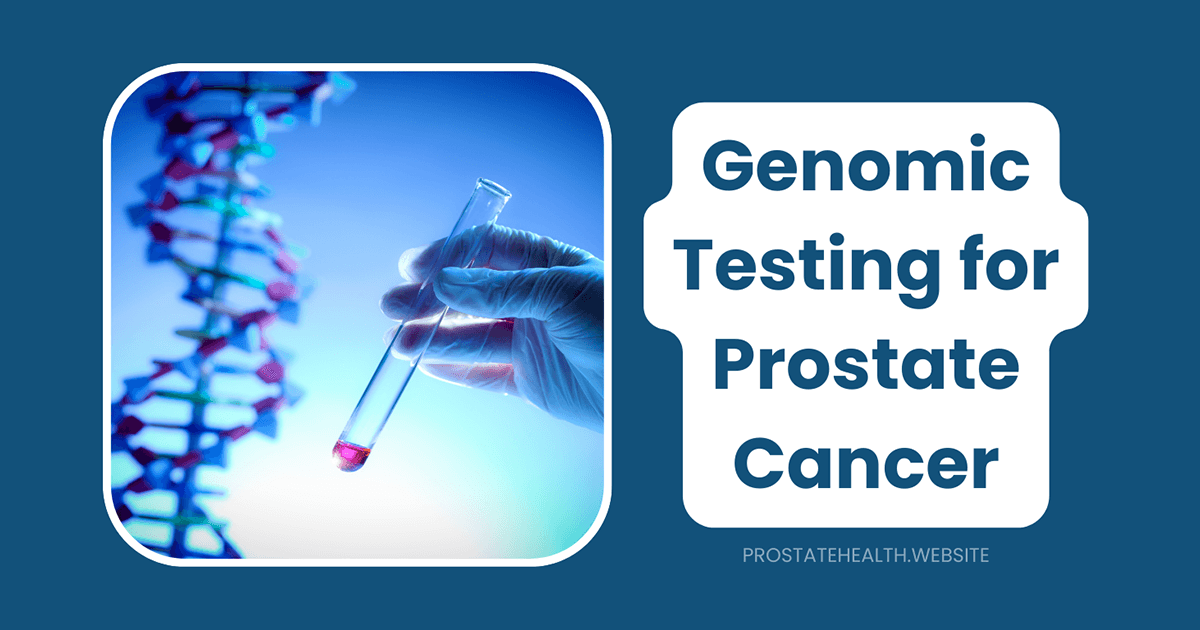Genomic Testing for Prostate Cancer: Who Benefits Most?

When faced with a prostate cancer diagnosis, one of the most challenging questions is: “How aggressive is my cancer, and what treatment approach is best for me?” Traditional clinical factors like PSA levels, Gleason scores, and clinical stage have guided these decisions for decades. But for many men, these measures leave a frustrating gray zone of uncertainty.
Enter genomic testing—a revolutionary approach that looks beyond what we can see under a microscope to examine the genetic makeup of your cancer. These tests analyze the activity of specific genes in your tumor to provide a more personalized assessment of your cancer’s aggressiveness and likely behavior.
As someone who’s spoken with hundreds of men navigating prostate cancer treatment decisions, I’ve seen firsthand how genomic testing can transform the decision-making process. But these tests aren’t necessary for everyone. Let’s explore what genomic testing is, who stands to benefit most, and how these tests are changing the landscape of prostate cancer care in 2025.
Understanding Genomic Testing for Prostate Cancer
Unlike genetic testing, which looks for inherited mutations in your DNA, genomic testing examines the activity of specific genes within your tumor cells. By analyzing patterns of gene expression, these tests can provide insights into how your cancer is likely to behave—information that can’t be determined from looking at the cells under a microscope.
The Major Genomic Tests for Prostate Cancer
As of 2025, there are several commercially available genomic tests for prostate cancer, each with specific applications:
Decipher Prostate
- What it analyzes: 22 genes from prostate tissue
- What it predicts: Risk of metastasis, prostate cancer-specific mortality, and response to treatment
- Sample source: Can be performed on biopsy samples or prostatectomy specimens
- Best for: Men considering active surveillance vs. treatment, or those making decisions about additional therapy after surgery
Prolaris
- What it analyzes: 31 genes related to cell cycle progression
- What it predicts: Risk of disease progression and prostate cancer mortality
- Sample source: Prostate biopsy or prostatectomy tissue
- Best for: Men deciding between active surveillance and definitive treatment, particularly those with intermediate-risk disease
Oncotype DX Genomic Prostate Score (GPS)
- What it analyzes: 17 genes involved in four biological pathways
- What it predicts: Likelihood of finding higher-grade or higher-stage disease at surgery, and risk of metastasis
- Sample source: Prostate biopsy tissue
- Best for: Men with newly diagnosed low or intermediate-risk prostate cancer making initial treatment decisions
ArteraAI
- What it analyzes: Digital pathology images combined with clinical information
- What it predicts: Risk of metastasis and benefit from hormone therapy
- Sample source: Prostate biopsy tissue
- Best for: Men with intermediate-risk disease considering hormone therapy in addition to radiation
How These Tests Work
The process is relatively straightforward from the patient’s perspective:
- Your urologist or oncologist orders the test
- The testing company retrieves a portion of your stored biopsy or surgical tissue
- The tissue is analyzed in a specialized laboratory
- Results are typically available within 1-3 weeks
- Your doctor discusses the results with you and how they might influence your treatment plan
Who Benefits Most from Genomic Testing?
While genomic testing can provide valuable information, it’s not necessary for every man with prostate cancer. Based on the latest research and 2025 guidelines, here are the groups who stand to benefit most:
1. Men with Favorable Intermediate-Risk Prostate Cancer
This is perhaps the group with the clearest benefit from genomic testing. If you have intermediate-risk prostate cancer (typically Gleason 3+4=7, PSA 10-20, or Stage T2b-c), you’re in a gray zone where both active surveillance and definitive treatment are reasonable options.
According to a 2025 study published in the Annals of Internal Medicine, genomic testing reclassified the risk for many intermediate-risk patients:
- Some were reclassified to lower risk, making active surveillance a more comfortable choice
- Others were reclassified to higher risk, suggesting the need for more aggressive treatment
The ASTRO 2025 guidelines note that Prolaris testing indicates approximately 70% of men with favorable intermediate-risk disease could safely consider active surveillance—a much higher percentage than previously thought.
As Robert, a 62-year-old patient with Gleason 3+4 cancer, told me: “My urologist recommended surgery, but my Decipher test showed my cancer was actually low-risk genomically. I’ve been on active surveillance for three years now, avoiding the side effects of treatment while keeping a close eye on things.”
2. Men with Low-Risk Disease and Concerning Features
While active surveillance is generally recommended for low-risk prostate cancer (Gleason 3+3=6, PSA <10, Stage T1-T2a), certain factors might raise concerns about this approach:
- High tumor volume (multiple positive biopsy cores)
- Strong family history of aggressive prostate cancer
- African American race (discussed in more detail below)
- Rapidly rising PSA
- Anxiety about monitoring rather than treating
For these men, genomic testing can provide reassurance about the safety of active surveillance or identify those who might benefit from early intervention.
The ENACT trial, presented in 2025, found that genomic testing with Oncotype DX GPS reclassified 34.5% of very low-risk and 29.4% of low-risk patients to a higher risk category, identifying men who might not be ideal candidates for active surveillance despite appearing low-risk by traditional measures.
3. Men Considering Additional Treatment After Surgery
If you’ve undergone radical prostatectomy and have adverse features in your pathology report (such as positive margins, extraprostatic extension, or seminal vesicle invasion), you may be considering additional treatment like radiation therapy.
Decipher testing on your prostatectomy specimen can help determine your risk of metastasis and guide decisions about:
- Whether adjuvant radiation is necessary
- Whether hormone therapy should be added to radiation
- The timing of salvage radiation if your PSA begins to rise
A 2025 study showed that Decipher testing changed treatment recommendations in approximately 30% of post-prostatectomy cases, either intensifying treatment for high-risk patients or sparing unnecessary treatment for low-risk patients.
4. African American Men
African American men face a 60% higher incidence of prostate cancer and twice the mortality rate compared to white men. Emerging research suggests that genomic testing may be particularly valuable for this population.
A 2025 study presented at the American Urological Association meeting found that when African American men with low or favorable intermediate-risk prostate cancer underwent genomic testing:
- 63.5% had a change in their risk designation
- Over 60% were reclassified to a higher risk category
- Among those with favorable intermediate-risk disease, 65% were upstaged after genomic testing
These findings suggest that traditional clinical risk factors may underestimate the biological aggressiveness of prostate cancer in African American men, and genomic testing may provide more accurate risk assessment.
As Michael, a 58-year-old African American patient, shared: “My doctor recommended genomic testing because of my race, even though my cancer appeared low-risk. The test showed I had a much higher risk of progression than expected. That information led me to choose treatment rather than active surveillance, a decision I’m grateful for.”
5. Men with Discordant Clinical Findings
Sometimes different clinical factors point in different directions:
- A low Gleason score but a high PSA
- A concerning MRI finding but a low-grade biopsy result
- A small amount of high-grade cancer in just one biopsy core
In these situations, genomic testing can help resolve the discordance and provide clearer guidance on the true biological potential of the cancer.
How Genomic Testing Influences Treatment Decisions
The primary value of genomic testing lies in its ability to inform critical treatment decisions. Here’s how these tests are typically used in clinical practice:
Active Surveillance vs. Definitive Treatment
This is the most common application of genomic testing. Research from 2025 shows that:
- In observational studies, genomic testing led to increased recommendations for active surveillance, with relative changes ranging from 7.5% to 61.8%
- Patients with low genomic risk scores were 2-3 times more likely to select active surveillance
- Among men who chose active surveillance based on favorable genomic test results, 91% remained on surveillance at 12 months
A 2025 study of Prolaris testing found that active surveillance selection rates were approximately twice as high in patients recommended to active surveillance by the test compared to those recommended for definitive treatment (41.8% vs. 20.7%).
Radiation Alone vs. Radiation with Hormone Therapy
For men with intermediate-risk prostate cancer undergoing radiation therapy, the addition of hormone therapy (androgen deprivation therapy or ADT) improves outcomes but comes with significant side effects.
According to the 2025 ASTRO guidelines:
- ArteraAI can predict whether ADT will be beneficial for men with intermediate-risk disease
- Decipher testing can help determine the potential benefit of ADT in men with rising PSA after prostatectomy
- Prolaris can provide the absolute risk reduction of using or omitting ADT, helping weigh benefits against side effects
Surgery Alone vs. Additional Treatment After Surgery
For men who have undergone radical prostatectomy, Decipher testing on the surgical specimen can guide decisions about adjuvant therapy:
- Low genomic risk: Observation may be appropriate even with adverse pathological features
- Intermediate genomic risk: Early salvage radiation may be considered if PSA becomes detectable
- High genomic risk: Immediate adjuvant radiation with or without hormone therapy may be warranted
Limitations and Considerations
While genomic testing offers valuable insights, it’s important to understand its limitations:
1. Not a Perfect Predictor
Genomic tests provide probabilities, not certainties. They improve risk stratification but cannot predict with 100% accuracy how an individual cancer will behave.
2. Sampling Issues
Like any test based on biopsy samples, genomic tests are subject to sampling error. If the biopsy missed the most aggressive area of the tumor, the genomic test results may underestimate risk.
3. Cost and Insurance Coverage
Genomic tests are expensive (typically $3,000-$5,000), though insurance coverage has improved significantly. As of 2025, Medicare and most private insurers cover these tests for appropriate indications, but coverage policies vary.
4. Limited Data in Certain Populations
Most validation studies for genomic tests have included predominantly white men. While emerging research is addressing this gap, particularly for African American men, more data is needed on the performance of these tests across diverse populations.
5. Evolving Technology
Genomic testing is a rapidly evolving field. Newer tests and updated versions of existing tests continue to emerge, potentially offering improved performance over time.
Real-World Impact: Patient Experiences
To understand the real-world impact of genomic testing, let’s look at how it has influenced treatment decisions for actual patients:
James, 65 – Favorable Intermediate-Risk Disease
“After my biopsy showed Gleason 3+4 cancer, my urologist recommended surgery. But given my age and other health issues, I wasn’t sure that was the right choice. My Prolaris test came back with a low score, indicating my cancer was likely to grow slowly. Based on those results, I chose active surveillance. Three years later, my PSA remains stable, and I’ve avoided the side effects of treatment.”
Thomas, 58 – Post-Prostatectomy Decision
“After my prostatectomy, my pathology showed positive margins, which meant some cancer cells might have been left behind. My doctor recommended radiation, but I was concerned about additional side effects. My Decipher test showed a low risk of metastasis, so we decided to monitor my PSA closely instead of immediate radiation. Five years later, my PSA remains undetectable.”
Michael, 54 – African American with Low-Risk Disease
“As an African American man with a family history of prostate cancer, I was nervous about choosing active surveillance despite my Gleason 6 diagnosis. My Oncotype DX test showed a higher risk score than expected for my clinical features. Based on those results, I opted for radiation therapy. In retrospect, I’m glad I had the genomic testing—it gave me confidence I was making the right decision.”
Questions to Ask Your Doctor About Genomic Testing
If you’re considering genomic testing, here are important questions to discuss with your healthcare provider:
- Based on my specific situation, would genomic testing provide valuable information?
- Which genomic test would be most appropriate for me and why?
- How might the results change my treatment options?
- Is genomic testing covered by my insurance? If not, what would be my out-of-pocket cost?
- How have genomic test results influenced treatment decisions for your other patients with similar clinical features?
- What are the limitations of genomic testing in my specific case?
- How will we integrate the genomic test results with other factors like my age, overall health, and preferences?
- If the test shows I’m low-risk, how confident can I be in choosing active surveillance?
- If the test shows I’m high-risk, what additional treatment options should I consider?
- How much experience do you have interpreting and applying genomic test results?
The Future of Genomic Testing
Genomic testing for prostate cancer continues to evolve rapidly. Here are some developments on the horizon:
Integration with Imaging
Researchers are working to combine genomic information with advanced imaging techniques like multiparametric MRI to create even more accurate risk assessment tools.
Liquid Biopsies
Future tests may be able to detect and analyze tumor DNA circulating in the bloodstream, potentially eliminating the need for tissue biopsies and allowing for more frequent monitoring.
Expanded Applications
Genomic testing is being studied for additional applications, such as:
- Screening high-risk individuals
- Monitoring during active surveillance
- Detecting recurrence after treatment
- Guiding treatment selection for metastatic disease
Artificial Intelligence Enhancement
AI algorithms are being developed to integrate genomic data with clinical factors, imaging findings, and other biomarkers to create more comprehensive and personalized risk assessments.
Conclusion: A Powerful Tool for Personalized Care
Genomic testing represents a significant advance in our ability to personalize prostate cancer treatment. By looking beyond what we can see under a microscope to examine the genetic drivers of cancer behavior, these tests help bridge the gap between population-based statistics and individual patient care.
While not necessary for every man with prostate cancer, genomic testing offers particular value for those in the gray zones of clinical decision-making—men with favorable intermediate-risk disease, those with discordant clinical findings, African American men, and those facing decisions about additional therapy after surgery.
As with any medical test, genomic testing should be viewed as one tool among many in the shared decision-making process between you and your healthcare team. When used appropriately, it can provide valuable information to help you make more confident, informed decisions about your prostate cancer care.
Have you or a loved one undergone genomic testing for prostate cancer? Share your experience in the comments below to help other men navigating this journey.






